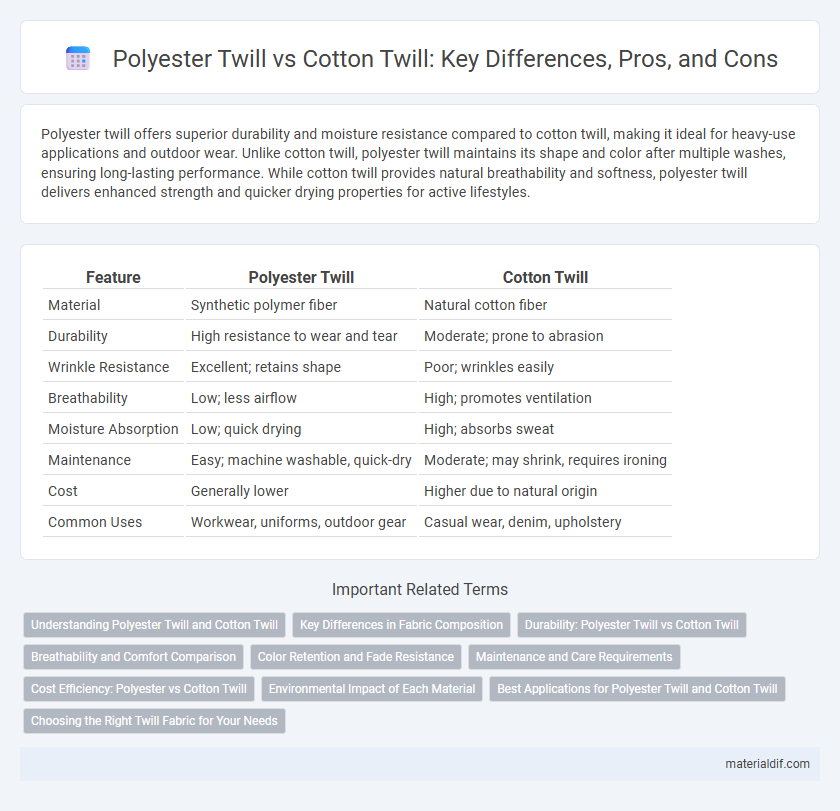Polyester twill offers superior durability and moisture resistance compared to cotton twill, making it ideal for heavy-use applications and outdoor wear. Unlike cotton twill, polyester twill maintains its shape and color after multiple washes, ensuring long-lasting performance. While cotton twill provides natural breathability and softness, polyester twill delivers enhanced strength and quicker drying properties for active lifestyles.
Table of Comparison
| Feature | Polyester Twill | Cotton Twill |
|---|---|---|
| Material | Synthetic polymer fiber | Natural cotton fiber |
| Durability | High resistance to wear and tear | Moderate; prone to abrasion |
| Wrinkle Resistance | Excellent; retains shape | Poor; wrinkles easily |
| Breathability | Low; less airflow | High; promotes ventilation |
| Moisture Absorption | Low; quick drying | High; absorbs sweat |
| Maintenance | Easy; machine washable, quick-dry | Moderate; may shrink, requires ironing |
| Cost | Generally lower | Higher due to natural origin |
| Common Uses | Workwear, uniforms, outdoor gear | Casual wear, denim, upholstery |
Understanding Polyester Twill and Cotton Twill
Polyester twill is a synthetic fabric crafted from polyethylene terephthalate fibers, offering superior durability, wrinkle resistance, and moisture-wicking properties compared to natural cotton twill. Cotton twill, woven from natural cotton fibers, boasts breathability, softness, and biodegradability, making it ideal for comfort-focused garments and eco-friendly applications. Both fabrics feature a distinctive diagonal weave pattern, but polyester twill excels in longevity and stain resistance, while cotton twill is favored for its natural feel and thermal insulation.
Key Differences in Fabric Composition
Polyester twill is composed primarily of synthetic polyester fibers, offering high durability, wrinkle resistance, and moisture-wicking properties. Cotton twill consists of natural cotton fibers, providing softness, breathability, and better heat insulation. Differences in fiber origin directly impact the fabrics' texture, strength, and performance in various applications.
Durability: Polyester Twill vs Cotton Twill
Polyester twill exhibits superior durability compared to cotton twill due to its synthetic fibers, which resist wear, abrasion, and stretching more effectively. Cotton twill tends to degrade faster under frequent use and washing because of its natural fiber composition. The enhanced tensile strength and moisture resistance of polyester twill contribute to its longer lifespan in heavy-duty applications.
Breathability and Comfort Comparison
Polyester twill offers enhanced durability and moisture-wicking properties but generally lacks the breathability of cotton twill, which excels at airflow and natural temperature regulation. Cotton twill provides superior comfort through its softness and ability to absorb sweat, making it ideal for warmer climates or extended wear. The choice between polyester and cotton twill depends on prioritizing moisture management and durability over natural breathability and comfort.
Color Retention and Fade Resistance
Polyester twill demonstrates superior color retention and fade resistance compared to cotton twill due to its synthetic fibers that resist UV exposure and frequent washing. The molecular structure of polyester minimizes dye loss, ensuring vibrant hues remain intact over extended use. Cotton twill, while breathable, tends to fade faster as natural fibers absorb dyes less securely and degrade under sunlight and laundry cycles.
Maintenance and Care Requirements
Polyester twill is highly durable and resistant to wrinkles, shrinking, and fading, making maintenance easier with minimal ironing and simplified washing instructions. Cotton twill requires more careful care, including gentle washing, frequent ironing, and potential shrinkage management to maintain its texture and appearance. Choosing polyester twill reduces long-term fabric upkeep and enhances fabric longevity compared to cotton twill.
Cost Efficiency: Polyester vs Cotton Twill
Polyester twill offers superior cost efficiency compared to cotton twill due to its lower raw material and production expenses. The durability and wrinkle-resistance of polyester twill reduce maintenance and replacement costs over time, making it a budget-friendly option for uniforms and workwear. In contrast, cotton twill requires higher upfront investment and frequent care, impacting overall long-term cost effectiveness.
Environmental Impact of Each Material
Polyester twill, derived from synthetic polymers, generally has a higher environmental footprint due to its reliance on non-renewable petroleum resources and the energy-intensive manufacturing process, contributing to microplastic pollution. Cotton twill, although natural and biodegradable, demands significant water usage and often involves pesticide application, impacting soil health and local ecosystems. Choosing between these fabrics involves weighing polyester's durability and recyclability against cotton's renewable origin and agricultural environmental costs.
Best Applications for Polyester Twill and Cotton Twill
Polyester twill excels in outdoor gear and uniforms due to its durability, wrinkle resistance, and moisture-wicking properties, making it ideal for heavy-use and weather-exposed applications. Cotton twill is favored for casual wear and upholstery where breathability, softness, and natural fiber comfort are prioritized. Both fabrics perform well in workwear, but polyester twill offers superior longevity and color retention under harsh conditions.
Choosing the Right Twill Fabric for Your Needs
Polyester twill offers superior durability, wrinkle resistance, and moisture-wicking properties, making it ideal for workwear and outdoor apparel. Cotton twill provides natural breathability, softness, and better comfort for casual wear and garments requiring frequent washing. Selecting the right twill fabric depends on balancing factors like durability, comfort, and care requirements to match your specific use case.
Polyester Twill vs Cotton Twill Infographic

 materialdif.com
materialdif.com